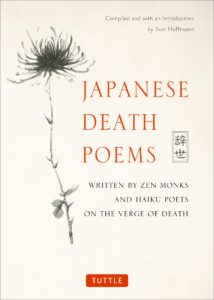Japanese Death Poems is one of those invaluable books for anyone interested in Japanese culture as well as poetry. The lengthy introduction alone is important for the plethora of information on the history of Japanese poetry and in particular, the death poem. From tanka to haiku, written by princes, court nobles, samurai, Buddhist monks and priests, the death poem became a widespread practice among the common people in the Meiji Period (1868-1912). Kamikaze pilots and officers in the Japanese Imperial Army all wrote them too.
The title of the book implies that the poems may be morbid, but this is not the case. In Japan, where life is often compared to a flower that soon withers, you can be assured that death is a journey at the end of which we all become enlightened. The poems tend to focus on nature, the change of seasons, and Buddhist imagery. Some are intentionally light and humorous. Others take your breath away:
Moon in the water
Somersaults
and streams away.
—by Oshima Ryota (1718-87)
Hakuro’s death poem imitates Bashō, and poet and Zen master Ikkyu (who “avoided neither taverns nor brothels, and never held his tongue”) penned his at the ripe age of 88, asking “Where is he who understands my Zen?” A good number of the poems are followed by explanations of poetic phrases and minutiae to help the reader understand deeper meanings.
The book is divided into three parts: the very thorough Introduction, Death Poems by Zen Monks, and Death Poems by Haiku Poets.
Between the covers of this book, you’ll find death poems of Yamato Teru no Mikoto (hero of the Kojiki), Hitomaro (from the Man’yōshū), the poet priest Saigyo (1118-90), Taira no Tadanori (1144-84) of Heike Monogatari, Yosa Buson (1716-83), Kobayashi Issa (1763-83), Hokusai (37 Views of Mt. Fuji), and oh so many more. You’ll discover plenty of other figures too, through their enlightening last words on life.
The book includes a valuable “Index of Poetic Terms” as well as a general index.
Review by Amy Chavez
This book was chosen as one of the top books of 2020. To read the entire list, see Our Reviewers Pick their Top Books for 2020.


